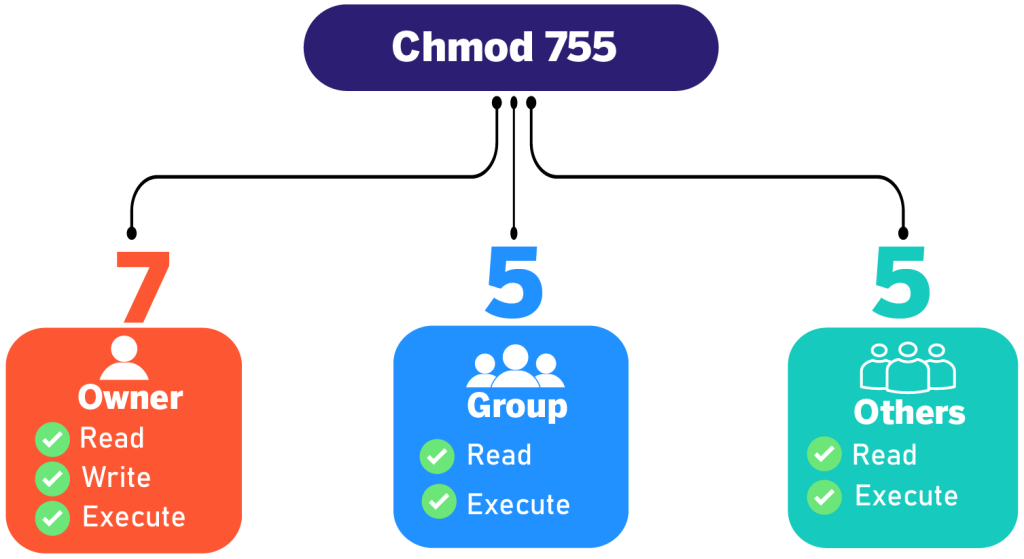The chmod 755 command is used to assign permissions to files, allowing the owner to read, write, and execute while enabling others only to read and execute.
File permissions define rules that control the accessibility of files and directories for various users. File permission is essential for managing access and preventing unauthorized modifications or access to files and directories in Linux.

This blog post will explore what chmod 755 command means, what permission is granted to different users, and when you should use this command in Linux.
Table of Contents
Basics File Permissions in Linux
Before jumping on chmod 755let’sand let’s know the basics of Linux permission. Linux has three user types: owner, group, and others. Each user can have different permissions for files. Here is a reference table explaining the Linux user categories:
| User | Description |
|---|---|
| Owner | The owner is the user who created and owns the file or directory. The owner has read and write permissions, allowing them to create, modify, or delete files. Only the owner or the superuser (root) can change file permissions. |
| Group | The group refers to a collection of members who share common file permissions. The group can have read, write, and execute permissions. |
| Others | Others include all users who are neither members of the group nor the owner. They can read, write, or execute files based on the permissions set by the owner or the superuser. |
In Linux, users have three types of permissions to manage files: read, write, and execute. Here is a reference table of Linux permissions and their descriptions:
| Permission | Symbol | Description |
|---|---|---|
| Read | r | Allows users to read, view, and download files. |
| Write | w | Allows users to write content, create, modify, or delete files. |
| Execute | x | Allows users to execute files, open applications, or run scripts. |
| No permission | – | Restricts users from reading, writing, or executing files or directories. |
These permissions can be represented in two formats: symbolic representation and numeric representation. The numeric notation, like chmod 755, represents file permissions using digits from 0 to 7, where each digit denotes a different permission set. Here is a table illustrating the numeric notation of file permissions:
| Permission Value | Binary Representation (rwx) | Permission Description |
|---|---|---|
| 0 | 000 | No permissions |
| 1 | 001 | Execute permission only |
| 2 | 010 | Write permission only |
| 3 | 011 | Write and execute permissions |
| 4 | 100 | Read permission only |
| 5 | 101 | Read and execute permissions |
| 6 | 110 | Read and write permissions |
| 7 | 111 | Read, write, and execute permissions |
Now that you have learned the basics of Linux file permission, let’s decode the meaning of chmod 755.
What Does chmod 755 Mean?
The command chmod 755 is used to set specific permissions for the owner, group, and others. Let’s say you want to apply chmod 755 permission to a file named myfile.txt.
chmod 755 myfile.txtLet’s break down the meaning of each digit in the command.
7: The owner of the file has read, write, and execute permissions. Inrepresentationentation, 7 is equivalent to 111, indicating that the owner has all three permissions.5: The group associated with the file has read and execute permissions. The digit 5 is equivalent to 101, meaning that the group has read and execute permissions but does not have write permission.5: Others (everyone else) have read and execute permissions for the file. In binary, 5 equals 101, indicating that others have read and execute permissions but do not have write permission.
In summary, chmod 755 sets the file permissions as follows: the owner has full permissions (read, write, and execute), the group has read and execute permissions, and others have read and execute permissions.
Alternatively, you can use the symbolic equivalent of the chmod 755 command, which sets the exact same permissions:
chmod u=rwx,go=rx myfile.txtWhen to Use chmod 755
The chmod 755 command is commonly used to set read and executable file permissions for groups and others while keeping full access to the owner, but it may not be suitable for every situation. Here are recommended use cases for the chmod 755 command:
1. Executable Scripts and Programs
The chmod 755 command is often used when a file needs to be executed by groups and users. It allows users to read and execute the file while granting full access to the owner. By using chmod 755, the file can be executed by the appropriate users while preventing them from modifying the file itself.
2. Web Server Files
In the context of a web server, the chmod 755 command is commonly applied. For example, if you run a WordPress website on a Linux server, WordPress needs to execute numerous scripts to function properly. By using chmod 755, the file permissions are set to ensure the proper functioning of WordPress while restricting other users from modifying the content. This helps maintain security.
3. Shared Files Accessible by Multiple Users:
When sharing files and directories among multiple users, especially if the files include executable files that need to be executed by both users and groups, chmod 755 is often the best permission option. This permission configuration allows for shared resources while protecting the files from unauthorized modifications.
Conclusion
In this blog post, I have covered the fundamentals of the chmod command and explained the meaning of the chmod 755 command. Additionally, I have provided examples and discussed the recommended use cases for utilizing chmod 755. By understanding the concept of file permissions and how they are applied through chmod, you can effectively manage access to files and directories in Linux.




